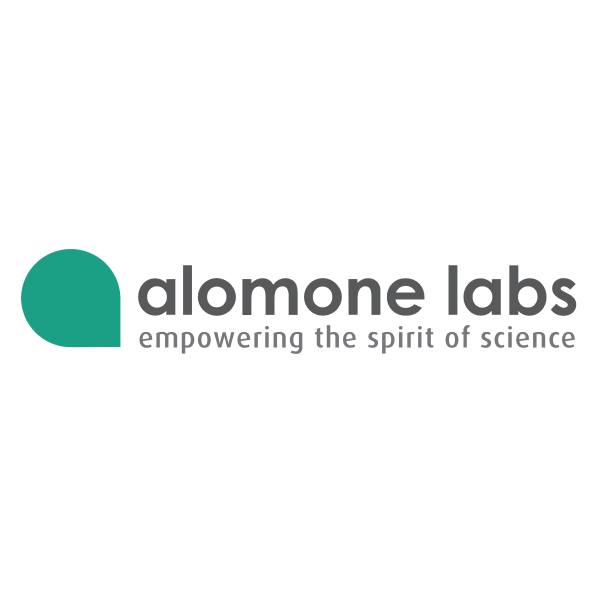

品牌: Alomone
 下载产品说明书
下载产品说明书 用小程序,查商品更便捷
用小程序,查商品更便捷



 收藏
收藏
 对比
对比 咨询
咨询纯度:
Affinity purified on immobilized antigen.
Affinity purified on immobilized antigen.
反应种属:
H, M, R
H, M, R
产品介绍
产品信息
纯化方式
Affinity purified on immobilized antigen.

宿主
Rabbit

免疫原
Peptide (C)KLMDRWKKLDQRE, corresponding to amino acid residues 274-286 of rat GluR4 (Accession P19493). Extracellular, N-terminus.

简单描述
A Rabbit Polyclonal Antibody to AMPA-Selective Glutamate Receptor 4 (GluR4)

商品描述
Alomone Labs is pleased to offer a highly specific antibody directed against an epitope of the rat ionotropic glutamate receptor 4. Anti-GluR4 (GluA4) (extracellular) Antibody (#AGC-019) can be used in western blot and immunohistochemistry applications. It has been designed to recognize GluR4 from rat, mouse, and human samples.

同种型
Rabbit IgG.

纯度
Affinity purified on immobilized antigen.

形式
Lyophilized

组成成分
谷氨酸受体4抗体;0.05%叠氮化钠溶液

基因
GRIA4

应用
实验应用
IF, IHC, WB

反应种属
H, M, R

背景
别名
AMPA Receptor 4, Glutamate receptor 4, Ionotropic glutamate receptor 4, AMPA-selective glutamate receptor 4, GRIA4, GluR-D

背景
Glutamate is the major excitatory neurotransmitter and modulates its effects via ionotropic and metabotropic receptors which are different in their molecular, biochemical, pharmacological and physiological properties1.
The ionotropic ligand-gated ion channel glutamate receptors are classified into three major subtypes, AMPA, kainate and NMDA receptors according to their selective agonist.
AMPA receptors consist of four closely related genes with about 70% homology that encode the four subunits GluR1-4. Their expression is known to be developmentally regulated2 and are also known to undergo alternative splicing. In fact, all four receptors have two splice variants, termed flip and flop, in an extracellular region adjacent to the M4 transmembrane region3. These splice variants are also developmentally regulated such that flip is expressed before birth and remains highly expressed throughout adulthood whereas flop expression is postnatal and reaches flip’s level in adulthood4.
In addition to their expression regulation, flip and flop also differ in their activation/inactivation kinetics. Each AMPA receptor contains 3 membrane spanning domains (M1, M3 and M4), while the fourth hydrophobic domain (M2) is a reentering cytoplasmic loop that forms part of the channels pore1. Different stoichiometries of these receptors form tetrameric structures to eventually form functional receptors5.
AMPA receptors are highly expressed in the brain. However, the GluR4 subunit is present in lower amounts in the CNS, except in the reticular thalamic neuclei and the cerebellum1.
The primary depolarization in glutamate neurotransmission is mediated by AMPA receptors, which are also key players in synaptic plasticity, learning and memory formation. The cellular distribution and post-translational modifications like phosphorylation are important for the activity of AMPA receptors and are thought to play a role in the long lasting and activity-dependent changes in synaptic strength6-9.
The ionotropic ligand-gated ion channel glutamate receptors are classified into three major subtypes, AMPA, kainate and NMDA receptors according to their selective agonist.
AMPA receptors consist of four closely related genes with about 70% homology that encode the four subunits GluR1-4. Their expression is known to be developmentally regulated2 and are also known to undergo alternative splicing. In fact, all four receptors have two splice variants, termed flip and flop, in an extracellular region adjacent to the M4 transmembrane region3. These splice variants are also developmentally regulated such that flip is expressed before birth and remains highly expressed throughout adulthood whereas flop expression is postnatal and reaches flip’s level in adulthood4.
In addition to their expression regulation, flip and flop also differ in their activation/inactivation kinetics. Each AMPA receptor contains 3 membrane spanning domains (M1, M3 and M4), while the fourth hydrophobic domain (M2) is a reentering cytoplasmic loop that forms part of the channels pore1. Different stoichiometries of these receptors form tetrameric structures to eventually form functional receptors5.
AMPA receptors are highly expressed in the brain. However, the GluR4 subunit is present in lower amounts in the CNS, except in the reticular thalamic neuclei and the cerebellum1.
The primary depolarization in glutamate neurotransmission is mediated by AMPA receptors, which are also key players in synaptic plasticity, learning and memory formation. The cellular distribution and post-translational modifications like phosphorylation are important for the activity of AMPA receptors and are thought to play a role in the long lasting and activity-dependent changes in synaptic strength6-9.

制备和贮存
溶解方法
25 µl, 50 µl or 0.2 ml double distilled water (DDW), depending on the sample size.

保存方式
The antibody ships as a lyophilized powder at room temperature. Upon arrival, it should be stored at -20°C.
数据库链接
Entrez-Gene ID
29629

UniProt ID
P19493

研究资源识别码
AB_10613117.

声明 :本官网所有报价均为常温或者蓝冰运输价格,如有产品需要干冰运输,需另外加收干冰运输费。







 危险品化学品经营许可证(不带存储) 许可证编号:沪(杨)应急管危经许[2022]202944(QY)
危险品化学品经营许可证(不带存储) 许可证编号:沪(杨)应急管危经许[2022]202944(QY)  营业执照(三证合一)
营业执照(三证合一)